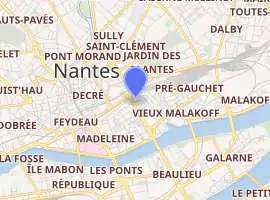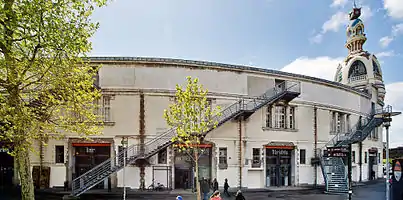Le Lieu unique
The lieu unique is a center for contemporary culture located in Nantes, France. Opened at the beginning of the 21st century, it is housed in a former biscuit factory at the center of the city. It was founded by Jean Blaise and is now directed (since January 2011) by Patrick Gyger.
| le Lieu unique | |
|---|---|

| |
| General information | |
| Location | Nantes, France |
| Address | Quai Ferdinand Favre 44000 nantes |
| Town or city | Nantes |
| Country | France |
| Coordinates | 47.215276°N 1.545749°W |
| Opened | 1 January 2000 |
| Design and construction | |
| Architect | Auguste Bluyssen ; Patrick Bouchain ; Jean-Marie Lepinay ; Nicole Concordet |

Presentation
Scène nationale of Nantes (center for contemporary culture), the lieu unique is a space for artistic exploration, cultural effervescence and conviviality that is internationally recognized for its spirit of curiosity in the different domains of art: visual art, theatre, dance, circus, music, but also literature, philosophy, architecture, and digital culture.
Every year the lieu unique presents dozens of shows (theater, dance, circus and music as well as concerts, literary gatherings, philosophical debates, exhibitions, residencies for artists, festivals).
History
From 1895 to 1985 - A biscuit factory
In 1895, the Nantes-based biscuit makers Lefèvre-Utile (LU), famous for their petit beurre cookies, built a factory on quai Ferdinand-Favre to develop new products. The structure, made entirely of concrete and metal, was innovative for its time and the two magnificent junction towers, which were added in 1909, make it one of Nantes’ most iconic buildings.
From 1986 to 1999 - The factory re-adapted in a cultural place
In 1986, and decades of expansion later, LU moved its production out of the city centre. Its factories were destroyed and only the annex of the quai Ferdinand-Favre now remains standing. As of 1989, artists (in particular, the Royal de
Luxe theatre troupe) began taking over the abandoned structure and turning it into a place of atypical creativity.
In 1994, in this abandoned building, the Centre de Recherche et de Développement Culturel (CRDC) a cultural association in Nantes, began to hold cultural events: Les Allumées (1990-91-92-93-94) ; Trafics (1996–97) ; Fin de siècle (1997-98-99).
Jean Blaise, Director of the CRDC at the time, convinced the city of Nantes to preserve the building and transform it into a new type of living cultural space, that could also be a meeting place outside of exhibitions and performances. He submitted a cultural project to Jean-Marc Ayrault, mayor of Nantes: to create a place where life would spontaneously be side by side with art, in its more contemporary or even disturbing ways. The project also included spaces of services (bar, restaurant, bookstore, day nursery, hammam).
In 1998, new restoration work[1] began, conducted by Jean-Marie Lépinay for the only remaining tower, as well as the rehabilitation of the factory by the french architect Patrick Bouchain, for one of his first big projects.[2]
The opening in 2000
The lieu unique opened on the 30th of December 1999, during the "End of century" festival in Nantes. This opening was marked by the Grenier du siècle (The Store of the century). A translucent double wall was designed to receive an important collection of objects given by the population. Put in cans, these objects are going to stay a whole century in this Store, until its opening on 1 January 2100 at 5pm.
Images of the lieu unique
From Outside
 Public entrance
Public entrance At the back
At the back The Tower
The Tower
On the First Floor
%252C_%22atelier_1%22.jpg.webp) Atelier 1
Atelier 1